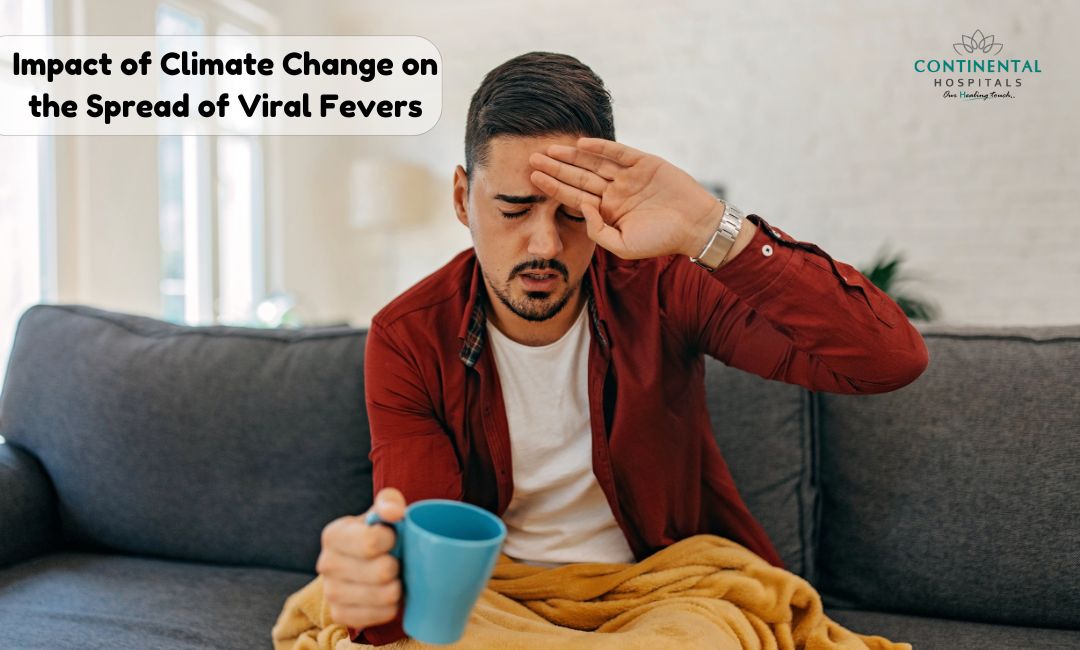Climate change is not just about rising temperatures and melting ice caps; it has far-reaching effects on global health. One of the most concerning impacts is the increase in the spread of viral fevers. From dengue and chikungunya to newer viruses, climate change is creating conditions that favor the proliferation of these illnesses. In this blog, we will explore how climate change is contributing to the spread of viral fevers, with a focus on worldwide and Indian-specific statistics. We'll also discuss treatment options available at Continental Hospitals in Hyderabad.
The Connection Between Climate Change and Viral Fevers
Viral fevers, caused by a range of viruses, are increasingly becoming a global health concern. Climate change plays a significant role in this trend by altering weather patterns, increasing temperatures, and affecting rainfall distribution. These changes create ideal conditions for the vectors—primarily mosquitoes—that transmit these viruses.
Worldwide Impact
Globally, the spread of viral fevers like dengue, Zika, and chikungunya is on the rise. According to the World Health Organization (WHO), the incidence of dengue has increased 30-fold over the past 50 years, with half the world's population now at risk. In 2019 alone, there were an estimated 390 million dengue infections worldwide. Similarly, the spread of Zika virus, which caused a global health emergency in 2016, is closely linked to changing climate conditions.
Indian-Specific Impact
In India, the situation is equally concerning. Rising temperatures and unpredictable monsoon patterns have led to an increase in the spread of viral fevers. The Indian Ministry of Health reports that the number of dengue cases in the country has nearly doubled over the past decade, with over 157,000 cases reported in 2019 alone. Similarly, chikungunya cases have surged, with states like Karnataka, Maharashtra, and Tamil Nadu being the worst affected.
🥗 Healthy Plate Challenge
🍽 Add Your Favorite Dish
Pick Your 6 favorite foods, eat, and see the results.Drag & drop foods onto your plate.
Drop Food Here
These statistics highlight the urgent need to address the impact of climate change on public health, particularly in regions like India, where the population density and tropical climate exacerbate the spread of these diseases.
How Climate Change Facilitates the Spread of Viral Fevers
Temperature Rise: Warmer temperatures accelerate the life cycle of mosquitoes, enabling them to breed more rapidly and increase in numbers. This directly leads to a higher transmission rate of viruses like dengue and chikungunya. Moreover, warmer climates extend the geographical range of these diseases, allowing them to spread to previously unaffected areas.
Increased Rainfall and Flooding: Climate change is causing more intense and unpredictable rainfall patterns. Increased rainfall and subsequent flooding create breeding grounds for mosquitoes, particularly in urban areas where water may stagnate in containers, puddles, or blocked drains. This surge in mosquito populations during and after the monsoon season leads to a spike in viral fever cases.
Longer Transmission Seasons: Traditionally, viral fevers like dengue were confined to certain seasons. However, climate change has extended the transmission season, allowing mosquitoes to thrive for longer periods. This prolongation results in more sustained outbreaks and a higher annual burden of disease.
Urbanization and Population Growth: In addition to climate change, rapid urbanization and population growth in India and other developing countries have contributed to the spread of viral fevers. Poor urban planning often leads to inadequate waste management and water storage practices, creating more opportunities for mosquito breeding.
Human Migration and Travel: Climate change-induced disasters such as floods and droughts force people to migrate. This movement of populations can lead to the introduction of viruses into new areas, contributing to the spread of viral fevers. Additionally, increased global travel facilitates the rapid spread of viruses across borders, making it a global health issue.
Mitigating the Impact of Climate Change on Viral Fevers
Addressing the impact of climate change on viral fevers requires a multi-faceted approach. While global efforts to combat climate change are crucial, localized strategies to control mosquito populations and prevent the spread of viral diseases are equally important.
Vector Control: Effective vector control is essential in reducing the spread of viral fevers. This includes measures such as spraying insecticides, eliminating standing water where mosquitoes breed, and promoting the use of mosquito nets and repellents.
Public Awareness Campaigns: Educating the public about the risks of viral fevers and how to prevent mosquito bites is crucial. Simple measures like wearing long-sleeved clothing, using mosquito repellents, and ensuring that water containers are covered can significantly reduce the risk of infection.
Improved Surveillance and Early Warning Systems: Governments and health organizations need to invest in better surveillance systems to monitor the spread of viral fevers. Early warning systems can help predict outbreaks and allow for timely interventions to prevent large-scale epidemics.
Vaccination and Medical Research: Continued research into vaccines for viral fevers like dengue is vital. While some vaccines are available, more effective and accessible options are needed, particularly for populations in high-risk areas.
Treatment Options at Continental Hospitals
Continental Hospitals in Hyderabad is well-equipped to handle viral fever cases, offering advanced diagnostics and treatment options for all types of viral infections. The hospital’s specialized infectious disease unit is supported by a team of highly qualified doctors who provide personalized care for viral fevers and their complications.
Treatment options include:
- Comprehensive Diagnostics: Accurate and fast detection of the virus through blood tests and imaging techniques.
- Symptom Management: Medications to reduce fever, body aches, and dehydration.
- Specialized Care for Complications: If the viral fever leads to complications like respiratory distress or organ damage, specialized care is available to manage these issues effectively.
- Preventive Counseling: Patients receive guidance on how to avoid future infections and manage their overall health.
Conclusion
The impact of climate change on the spread of viral fevers is undeniable. Rising temperatures, unpredictable rainfall, and extended transmission seasons have created a perfect storm for the proliferation of diseases like dengue, chikungunya, and Zika. In India, where these factors are compounded by rapid urbanization and high population density, the threat is particularly acute.
Take control of your health. If you or someone you know is experiencing symptoms of a viral fever, consult our General physician at Continental Hospitals today.
Related blogs:
.webp)














